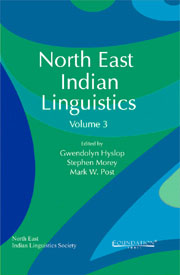Book contents
- Frontmatter
- Contents
- About the Contributors
- Foreword
- A Note from the Editors
- The View from Manipur
- The Sal Group
- Tibeto-Burman Nominalization
- Tani
- Eastern Indo-Aryan
- 11 The Referring Systems and the Determinative Elements of Noun Phrases in Assamese
- 12 Copular Sentences in Asamiya
- 13 Case Marking in Hajong
- Austroasiatic
13 - Case Marking in Hajong
from Eastern Indo-Aryan
Published online by Cambridge University Press: 26 October 2011
- Frontmatter
- Contents
- About the Contributors
- Foreword
- A Note from the Editors
- The View from Manipur
- The Sal Group
- Tibeto-Burman Nominalization
- Tani
- Eastern Indo-Aryan
- 11 The Referring Systems and the Determinative Elements of Noun Phrases in Assamese
- 12 Copular Sentences in Asamiya
- 13 Case Marking in Hajong
- Austroasiatic
Summary
Introduction
The Hajong group is one of the scheduled tribes of North East India. They live mainly in Assam and Meghalaya in India and in the Mymensingh District of Bangladesh. Hajong is classified in the Ethnologue as Indo-European > Indo-Iranian > Indo-Aryan > Eastern zone > Bengali- Assamese (Gordon 2005). Although Hajong is classified as Indo-Aryan (IA), several Hajong case markers are not cognate with those of the large neighbouring IA languages, Bangla and Asamiya. This raises the question of the origin of these case markers. Some authors have speculated that the Hajong language has a Tibeto-Burman (TB) sub-stratum. The Hajong people are ethnically and culturally closer to the surrounding Tibeto-Burman people groups such as Garo and Koch than to the Bengali population. The cultural and linguistic similarities could be due either to a common origin or to a mutual influence between the groups who have been living in proximity for generations.
In this paper, I will describe the system of case marking in Hajong – that is, the morphemes which specify the syntactic function of the noun phrase. I will describe the syntactic functions associated with each case form and I will compare the Hajong case forms to their equivalents in four geographically proximate languages. From the IA family, Hajong will be compared to Standard Colloquial Bangla (Dasgupta 2003) and Standard Colloquial Asamiya (Goswami and Tamuli 2003) (both classified as Indo-European > Indo-Iranian > Indo-Aryan > Eastern zone > Bengali-Assamese).
- Type
- Chapter
- Information
- North East Indian Linguistics , pp. 223 - 238Publisher: Foundation BooksPrint publication year: 2011
- 1
- Cited by



